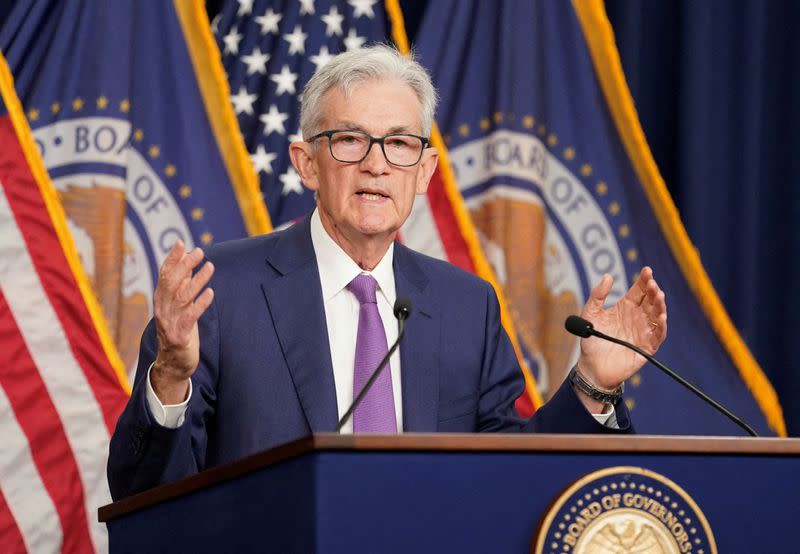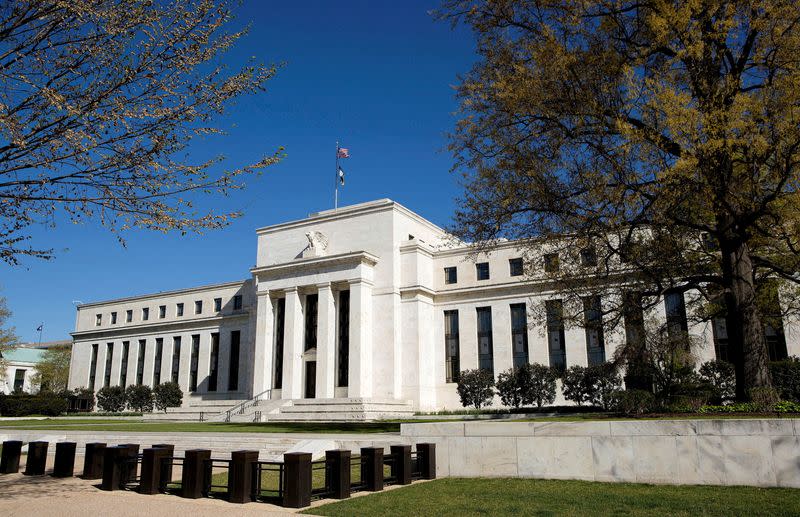Fed shifts talk to 'scenarios' as policy grows less certain
By Howard Schneider
WASHINGTON (Reuters) - Federal Reserve Chair Jerome Powell said in a May 1 press conference he didn't want to talk about economic "hypotheticals," but that's what he and other U.S. central bank officials have shifted towards in discussing monetary policy that has hit an uncertain juncture in the effort to tame inflation.
Dropping what had been explicit guidance about the likelihood of interest rate cuts this year, Powell and other Fed officials are instead focusing attention on broadly different near-term paths the economy might follow, and their likely reaction to each case.
Former Fed officials and staffers with experience attending meetings of the policy-setting Federal Open Market Committee say that's a sign of just how uncertain policymakers feel right now and is meant to shift attention from the detailed economic and policy projections they produce each quarter and onto a wider array of potential outcomes.
"Scenario analysis," as it's known, isn't meant to account for every shock, and in normal times can amount to a "quite mundane" list of economic narratives presented by Fed staff at each meeting, said Antulio Bomfim, a former Powell adviser who is now head of global macro for Northern Trust's global fixed income team.
But Powell's elaboration in his post-meeting May 1 press conference about different paths the economy might follow "caught my attention," Bomfim said. "Scenario analysis becomes important to handle those situations where you're especially uncertain about what's coming next."
The minutes from that meeting are scheduled to be released on Wednesday and could provide more details on the shift in approach.
In a recent policy review for the Bank of England, former Fed chief Ben Bernanke recommended scenario analysis as a way, the BoE said, "to consider the key risks to the macroeconomic outlook" and help the public understand how the central bank would respond - a benefit some Fed officials appear to be seeking.
"The reaction to uncertainty, to me, isn't to make more projections," San Francisco Fed President Mary Daly said earlier this month. "There's a range of scenarios under which you would do different policy actions. And I think the best way I can talk to people is go through those scenarios and really reveal the reaction function" - not try to make more precise predictions.
'DOT-PLOT' DEFLECTION
If the Fed's baseline is for a continued drop in inflation and eventual rate cuts, alternatives include U.S. joblessness starting to rise and cuts coming fast; inflation taking a long time to decline and cuts being delayed; inflation unexpectedly accelerating and rate hikes becoming warranted; and, perhaps the trickiest case, inflation sticking at the current level.
Laying all that out, without committing, is a challenge. If public and market perceptions run too far ahead of or lag the Fed, it can make policy less effective and the central bank's job harder.
Following the Bernanke report and an unanticipated stalling of progress in lowering inflation, "I infer this is getting some discussion inside the Fed," said Donald Kohn, a former Fed vice chair who is now a senior fellow at the Brookings Institution.
Kohn saw scenario analysis as a way of "reducing the focus" on Fed officials' quarterly projections for growth, joblessness, inflation and the appropriate policy rate. Those projections are set to be updated at the June 11-12 meeting.
The "dot plot" of policy rate projections in particular has been both leaned on by Fed chiefs when it is seen helping anchor public perceptions, and declared a distraction when it is taken as something close to a promise at times when officials don't want to offer concrete guidance.
Now is such a moment when surprises about the economy have outrun the quarterly updates. The median projection at the March 19-20 meeting, for example, was for three quarter-percentage-point rate cuts this year, but that will likely be scaled back after the lack of improvement in inflation in the first quarter.
Any projection about cuts at this point would depend on the outlook for inflation and the job market, and both have behaved much differently than policymakers expected.
Fed officials may retain a baseline confidence in easing inflation and rate cuts, but "they do think that uncertainty is higher than usual and this is a way of trying to convey to the public" the most likely alternatives, said Bill English, a former head of the Fed's monetary policy division who is now a professor at the Yale School of Management.
'OPPORTUNISTIC DISINFLATION'
Fed projections also include data showing the extent of doubt around the outlook. In March, for example, the median projection saw the personal consumption expenditures price index - the central bank's preferred inflation gauge - ending 2024 at 2.4%, approaching the 2% target. But officials also saw a 70% probability it could actually be as low as 1% or as high as 3.8% - outcomes that would inspire dramatically different policy decisions.
Charts including those confidence bands are published with the projections but don't get the same attention as the median.
Talking through a set of scenarios, by contrast, is "a way of making concrete to the public why things are uncertain ... Now it seems helpful because they feel some of the scenarios are more plausible," English said.
Uncertainty about the economy has been a hallmark of the COVID-19 pandemic era, but in the current moment there are not only questions about key variables like inflation and employment, there's doubt about what conditions would prompt the Fed to cut interest rates, hold them steady, or raise them again.
On May 1 Powell discussed a baseline of continued inflation decline that would eventually warrant rate cuts, a slide in the job market that would also lead to lower borrowing costs, and a situation where unemployment remains low with PCE "moving sideways" around the current 2.7% level.
"That would be a case in which it could be appropriate to hold off on rate cuts" and trust the economy would eventually slow and inflation decline, Powell said, what some analysts have called a wait for "opportunistic disinflation."
The Fed could be patient in that situation only as long as inflation expectations did not rise, said Kohn, the former Fed official. If they did, it "would argue for a more assured path to 2 (percent) by slowing the economy and reducing pressure on labor markets."
(Reporting by Howard Schneider; Editing by Dan Burns and Paul Simao)

 Yahoo Finance
Yahoo Finance 

